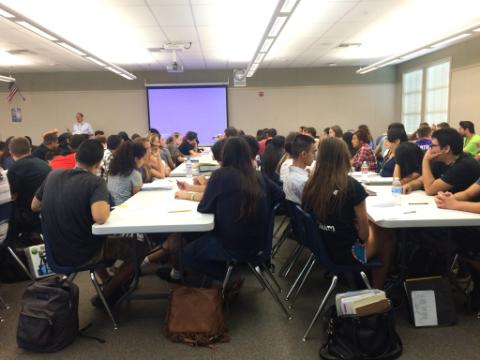Math, science students collide in Net Logo presentation

Collaboration between physic and math students.
September 29, 2015
Many new exciting activities are arising in classes and grade levels, particularly in Dean Reese’s IB-Physics and Conceptual Physic classes.
Students were asked to participate in a car collision lab/contest on Sept. 14, with David Daily’s math students and Reese’s physics students teaching each other concepts and using them in a car collision contest held on Sept. 16.
The Secondary Integration of Modeling in Math and Science (Simms), project had a big part in this car collision contest as well as other teachers in the county. The purpose of this lab was for students to make a simulation on Net Logo in order to calculate the time two cars would collide
“I have been working with Mr. Daily and other math and science teachers and teaching them how to use Net Logo,” Reese said. One of the things we are doing for this project is having collaboration between math and science teachers to find how we can both use Net Logo to address science and math standards.”
“Whenever you are creating a new project that you have never done before, you are just kind of hoping that it all works out, that students learn, it is not a waste of time, and that it is a productive learning experience,” Reese, when recapping his expectations of this lab, said.
“I do think that the collaboration between math, science, and Net Logo learning how to computer code is valuable,” Daily said.
However, Daily said, “There were lots of things I would have changed in the project. Since it was the first time going through, a little more information on the timeline would be helpful for students, but it is normal for a teacher to be editing stuff.”
“My favorite part was doing the Net Logo simulation on the computer,” senior Sonia Reddy, in Reese’s third period physics class, said, “I liked how we got to interact with different people and had to teach them about physics and them teaching us about math. It was a productive way of learning both skills.”
In order for students to predict where the cars would collide, both math and physics were taken into consideration
“We predicted the collision by using Net Logo and using the math that we learned when interacting with the math kids, using their math formulas to predict the final point,” Reddy said.
However, Reddy’s lab group was off by 25cm or .25meters of where the actual point of collision had taken place.
https://www.youtube.com/watch?v=ud4PYoKu6e4
